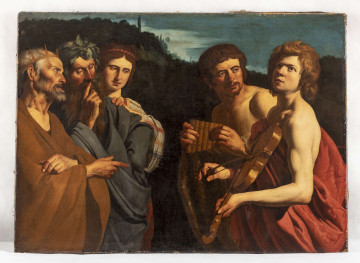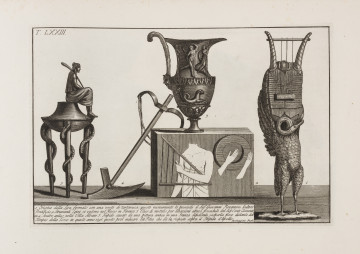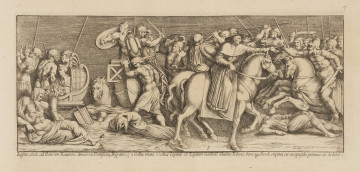
Judgement of Midas
1630 — 1650
National Museum in Lublin
Part of the collection: Italian graphics
A mythological scene engraved by Carlo Labruzzi (1748-1817) after an original by Michelangelo Buonarotti (1475-1542) shows one of the acts of Apollo, the protector of the fine arts, who, in the presence of the Olympian gods, orders the skinning of Marsyas. A bare body of Marsyas hangs suspended along the trunk of a dry tree, to which he has been tied by his wrists. A syrinx - the musical instrument he used to play - is placed in front of him. An executioner kneels at his feet and, holding a knife, grabs the musician by the leg to skin him. The punishment is to be imposed for the fact that Marsyas dared to compete with Apollo on the beauty of instrument play. As the god sits beside him, on a stone, with a lyre in hand, an agitated Hercules supported on a mace and several gods: Mercury, Venus, Mars, and Zeus stand behind him. Across from Apollo, on the other side of the tree, sits King Midas wearing a cap, covering his donkey ears, and a crown. Standing behind him are the citizens of the kingdom. Further in, within a grove overgrowing a mountain slope, two figures despair over the martyrdom of Marsyas. The composition Apollo alla presenza di molti Numi ordina sia scorticato Marsia probably comes from a series of 12 boards for Nicola Passerini's work Cenni dopo le opere di Michelangelo a Firenze published in Rome at the beginning of the 19th century, the German edition of which was named Umrisse nach den Werken des Michelangelo in Florenz. Carlo Labruzzi, a draughtsman, painter and engraver, was admitted to the Congregazione Virtuosi in 1781 and to the Academy of St Luke in 1796 and initially painted landscapes with historical staffage. In his later years, he produced compositions on a variety of subjects. While in Poland in 1778, he painted portraits of the Potocki family. From 1814 he held the position of head of the Perugia academy. He collaborated with the offices Kunstverlag Frauenholz in Nuremberg and Dall'Armi in Rome. He made a series of contour engravings based on Masaccio's paintings (1401-1428) in the Basilica of San Clemente in Rome and Michelangelo's works in Florence, as well as a series of city views of Rome and the surrounding area. His specialisation involved drawing typical figures, groups of figures, and garments, which were published in several series. Ewa Gwiazdowska
Author / creator
Object type
graphic
Technique
etching
Material
Velin paper
Origin / acquisition method
acquisition
Creation time / dating
Creation / finding place
Owner
Muzeum Narodowe w Szczecinie
Identification number
Location / status

1630 — 1650
National Museum in Lublin

1804
National Museum in Szczecin

1680
National Museum in Szczecin
DISCOVER this TOPIC
National Museum in Lublin
DISCOVER this PATH
Educational path